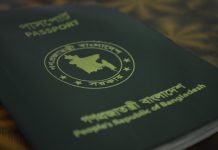The Indian media’s portrayal of Bangladesh turmoil as religiously motivated has fueled misinformation and has strained Bangladesh-India relations, posing a threat to regional stability
This article has been published in the Dhaka Tribune on August 27, 2024.
The youth-led uprisings in Bangladesh culminated in the historic resignation of Sheikh Hasina, marking the end of an era and plunging the nation into a period of unprecedented uncertainty. Immediately after her resignation, there was a nationwide interruption of law and order.
Courtesy: Dhaka Tribune
Police forces were noticeably absent from their posts, leaving the streets unguarded and the public in heightened anxiety. This sudden power vacuum created a volatile and messy situation, and the country grappled with the aftermath of a revolution, destabilizing the nation.
Attacks have taken place on Awami League offices, leaders’ homes, and businesses in various districts. Hindu communities have also been targeted in some cases, raising concerns over rising communal violence.
Subsequently, several Indian media outlets have circulated accounts of widespread attacks against the Hindu community in Bangladesh, raising serious concerns about the ulterior motives behind these reports.
If one is going to repetitively point to Hindu victimhood, overlooking the wider political context, then one is sure to create a one-way inflammatory discourse that does little to promote understanding or peace. Indian media has largely portrayed these motivated attacks as a broader crisis — one religiously charged, broadly against the Hindu community.
They have circulated false claims with doctored images exaggerating the scale and nature of violence against the Hindu community in Bangladesh. Such manipulative media narratives with striking visual content only exacerbates the prevalence of misinformation and disinformation.
Independent fact-checking organizations like Fact-Watch, along with national and international media outlets, have played a crucial role in debunking these false claims. Their analysis has revealed a systematic effort to distort the truth, with many of the viral posts being either outright fabrications or gross exaggerations of actual events.
It was true that Fact-Watch’s fact-checking of the video concerning the temple attack did prove that it took place in a separate, unrelated incident years earlier—the footage of which was being repackaged with the intent to inspire fear in its audience.
For example, Republic Bangla aired a report claiming there was an attack at the Nabagraha Temple when Sudarshan News broadcast the Lakshmipur shop fire video as part of their coverage of supposed attacks on Hindus. Those reports have been widely shared and viewed, contributing to a growing perception in India that Hindus in Bangladesh are under siege.
However, Fact-Watch debunked this claim, revealing that the fire had occurred at the south district Awami League office near the temple, not the temple itself. Another instance of misinformation involved a video showing a woman being abducted in Senbagh, Noakhali, claiming that it depicted a communal attack against Hindus. However, further investigation revealed that the incident was a domestic dispute unrelated to any communal violence.
Similarly, a video showing a shop on fire in Lakshmipur was falsely presented as evidence of recent anti-Hindu violence, even though the incident occurred weeks before the political unrest and was not related to any religious conflict.
The conflation of these genuine incidents with exaggerated or false reports has made it difficult to discern the true extent of the threat facing Hindus in Bangladesh.
The Times Group-owned Mirror Now, for instance, released a video titled “Attack on Hindus in Bangladesh? Genocide, Murder by an Enraged Mob,” which depicted scenes of violence and burning. However, investigations by Al Jazeera and other independent fact-checking organizations have shown that the claims were grossly exaggerated and those two houses were actually Muslim-owned.
The conflation of these genuine incidents with exaggerated or false reports has made it difficult to discern the true extent of the threat facing Hindus in Bangladesh
Many of the targeted individuals were affiliated with the Awami League, suggesting that the violence was rooted in political retribution rather than communal hatred. In districts like Narsingdi and Jessore, where attacks were reported, residents have confirmed that the violence was directed at individuals based only on their political affiliations.
Gobinda Chandra Pramanik, a prominent leader of the Hindu community in Bangladesh, has asserted the same.
But by framing the unrest in Bangladesh as a religious conflict, these outlets and social media accounts are arguably attempting to rally Hindu nationalist sentiment within India. Such a portrayal of Bangladesh as a hostile, anti-Hindu neighbour fits neatly into the agenda of right-wing political groups in India, who have long sought to portray Hindus as under siege in the region.
The fear-generated narratives have not only fueled communal tensions but have also been used to justify calls for a more aggressive stance towards Bangladesh.
Meanwhile, many in Bangladesh, including members of the Gen-Z cohort, have taken proactive steps to protect Hindu temples and households from vandalism — a fact that is rarely highlighted in Indian coverage.
Foreign Affairs adviser Md Touhid Hossain has criticized the Indian media for broadcasting the recent events in Bangladesh in a “highly exaggerated” manner. He argued that this kind of reporting not only distorts the truth but also harms the diplomatic relationship between the two countries.
Similarly, while talking with Indian Prime Minister Narendra Modi over the telephone, Professor Muhammad Yunus made bold remarks about the exaggerated reports of attacks on minorities, going so far as to invite Indian journalists to visit Bangladesh and report from the ground. Yunus’s call for transparency and accuracy in reporting is a direct challenge to the current media narrative, urging a more truthful representation of events.
The framing of these incidents undermines the sovereignty of Bangladesh, painting it as a nation incapable of protecting its minority communities without external intervention. This is not favourable to upholding healthy diplomatic relations and could have long-term consequences for the region’s stability.
The growing distrust stems from a perception that India has not acted in the best interests of Bangladesh, particularly in the wake of the recent political reforms and the fall of the Sheikh Hasina government. Accordingly, Bangladesh believes India has overstepped its bounds, interfering in their internal affairs and failing to respect its sovereignty.
If the current trajectory continues, the relationship between these two historically linked nations could be strained, with repercussions for the broader South Asian region.
Zulker Naeen is a Research Coordinator at the Centre for Critical and Qualitative Studies, at the University of Liberal Arts Bangladesh. He is reachable at naeenzulker@gmail.com









[…] his working portfolio demonstrates his expertise in climate change journalism, digital literacy, misinformation research, fact-checking, sustainable development, and policy analysis. His engagements highlight a […]